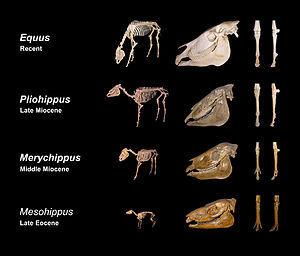

The evolution of the horse, a mammal of the family Equidae, occurred over a geologic time scale of 50 million years, transforming the small, dog-sized,[1] forest-dwelling Eohippus into the modern horse. Paleozoologists have been able to piece together a more complete outline of the evolutionary lineage of the modern horse than of any other animal. Much of this evolution took place in North America, where horses originated but became extinct about 10,000 years ago,[2] before being reintroduced in the 15th century.
The horse belongs to the order Perissodactyla (odd-toed ungulates), the members of which all share hooved feet and an odd number of toes on each foot, as well as mobile upper lips and a similar tooth structure. This means that horses share a common ancestry with tapirs and rhinoceroses. The perissodactyls arose in the late Paleocene, less than 10 million years after the Cretaceous–Paleogene extinction event. This group of animals appears to have been originally specialized for life in tropical forests, but whereas tapirs and, to some extent, rhinoceroses, retained their jungle specializations, modern horses are adapted to life in the climatic conditions of the steppes, which are drier and much harsher than forests or jungles. Other species of Equus are adapted to a variety of intermediate conditions.
The early ancestors of the modern horse walked on several spread-out toes, an accommodation to life spent walking on the soft, moist ground of primeval forests. As grass species began to appear and flourish, the equids' diets shifted from foliage to silicate-rich grasses; the increased wear on teeth selected for increases in the size and durability of teeth. At the same time, as the steppes began to appear, selection favored increase in speed to outrun predators. This ability was attained by lengthening of limbs and the lifting of some toes from the ground in such a way that the weight of the body was gradually placed on one of the longest toes, the third.
- ^ Legendre, Serge (1989). Les communautés de mammifères du Paléogène (Eocène supérieur et Oligocène) d'Europe occidentale : structures, milieux et évolution. München: F. Pfeil. p. 110. ISBN 978-3-923871-35-3.
- ^ Singer, Ben (May 2005). A brief history of the horse in America. Canadian Geographic Magazine. Archived from the original on 2012-01-07. Retrieved 22 December 2017.